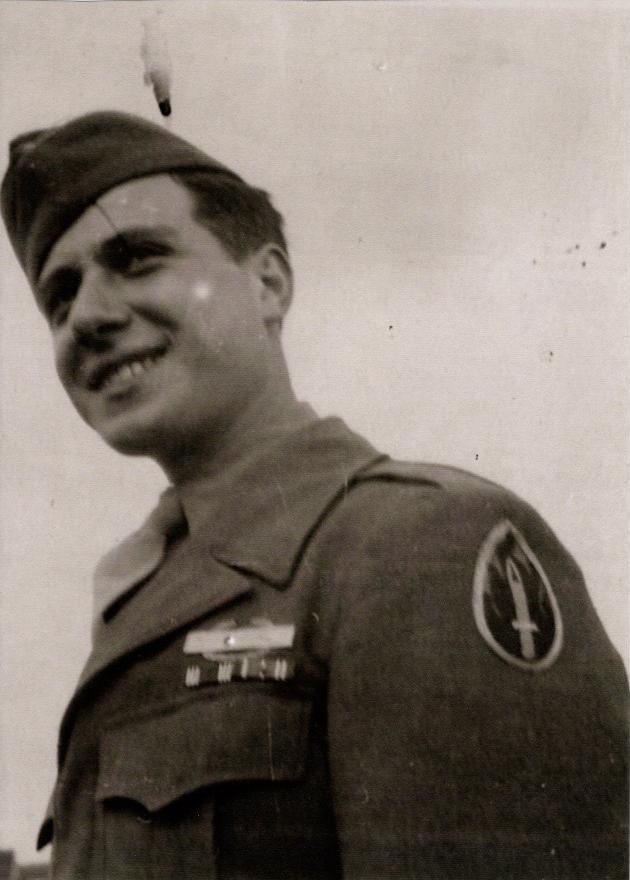Private First Class Herman Fabiani 36978181 
Private First Class Herman Fabiani 36978181 US Army. He was born in 1926 in Melrose Park, Illinois. The son of Dominick Fabiana and Mary Fabiana. He was drafted into the US Army during his senior year of high school. At the time of his enlistment he was 5 foot 10 inches weighed 165 pounds had Black hair and brown eyes. He trained at Camp Van Dorn Mississippi. He served in Combat with Third Platoons, Company F, 253rd Infantry Regiment, 63rd Infantry Division. Fabiani was most likely the only man in F Company that came with the company from Camp Van Dorn that did not get wounded during the war. In Combat he wore German suspenders to hold his ammo belt, and he served as first scout for the Third Platoon. He earned a Bronze Star Medal for Valor on February 24, 1945, a medal that he did not learn about until he got home from the war.
Some of the events that PFC Fabiani took part in at the Battle of Buchhof:
On April 6, 1945,Third Platoon was leading the attack to the town of Buchhof. Because PFC Fabiani was first scout for the Third Platoon, he was now leading the company. PFC John D. Harris, who was second scout, followed immediately behind Fabiani. During the one and three-fourths mile advance, the company had to clean out several machine gun and sniper positions while receiving artillery fire. This caused the advance to Buchhof to take about three and a half hours. Fabiani was the first person to reach the outskirts of the town of Buchhof from the east shortly before 1100 hours. Fabiani saw a glimmer coming from a sand stone church with a steeple on top of the hill in the town of Buchhof, and he fired his rifle at it. Then “all hell broke loose.” Meanwhile, PFC Harris who was closest to Fabiani, discovered that the enemy was waiting to ambush his platoon. When Fabiani fired at the church, the enemy immediately opened fire on Third Platoon. The enemy used a tremendous amount of artillery fire that began falling down on the company, along with mortar, rocket, large amounts of small arms, and machine gun fire. PFC Harris warned Third Platoon, “giving them time to get into a position as the enemy fire became more intense and was taking heavy, [amounts] of casualties… the platoon was forced to withdraw, to “a more advantageous position” to push the attack on Buchhof.
According to the American After Action Reports, after taking the town of Buchhof; “At 1230 hours, after clearing the snipers from Buchhoff Germany, F and G companies were attacked by 30 men they drove off this counterattack, inflicting heavy casualties.” According to the German reports this was a recon not an attack the men were seen which resulted, the 17th SS calling in mortar, artillery, and rocket fire on the american, all of the 17th SS soldiers that were on the recon were killed. When the 17th SS called in the Mortar fire, one of the mortar pieces landed, hitting T/Sgt Willie Overfelt of Third Platoon, wounding him, “mangled his two legs.” At this point, PFC Fabiani and the Company Commander First Lieutenant Frank Schaafsma rushed over and they “were working on making a rain coat stretcher to get Willie out of harms way.” As they were getting him ready, to put him on the stretcher, another artillery shell hit at their position and sent PFC Fabiani and Lt. Schaafsma about 10 feet into the air. PFC Fabiani landed without a scratch. Schaafsma was wounded and, Sergeant Overfelt died before ever coming close to the field hospital.
At around 1545 hours, Lieutenant Alfred Peshel was jumping from foxhole to foxhole checking on his men. He had been the unofficial company commander for two hours and forty-five minutes. He jumped in to Herman Fabiani’s foxhole and casually said “Hey Fab!” He then was asking Fabiani how he was doing with supplies such as ammo and water. Peshel then jumped out of Fabiani’s foxhole and was running to “the next foxhole when a sniper shot Peshel in-between the eyes.” Immediately after the sniper killed Peshel, the enemy launched another counter attack – this time with up to 250 men and several tanks, supported by artillery, rocket, and mortar fire. Fabiani helped defined the town during the close quarter combat until dusk when the 17th SS was forced to withdraw. The Germans moved their forces to the next town and began to set up defenses of the town of Stein-am-Kocher for the next American attack. Companies F, Company B, and G Company were on the high ground, northwest of the town.
At 0200 on 7 April, Fabiani and a PFC from F Company that had earned a Purple Heart with the company in February, were on guard watching for any enemy that may try to attack that night. Fabiani was “running low on ammo for a 30 caliber machine gun and [he] told the PFC to go get more ammunition … at this point the PFC just walked away from F Company. No one found the PFC until after the war.”
Fabiani fought with the company until Victory in Europe (VE) Day, Shortly after VE day he went to the hospital for trench foot, and returned to F Company. He served 119 days in combat from November 1944 – May 1945. He earned the Presidential Unit Citation for the fighting he took part in from April 2 – 12 1945.
He was awarded the Combat Infantry Badge, the Bronze Stare Medal with oak leaf Cluster and a V for Valor, The American Theater of operations, the European Theater of Operations Medal ETO with 2 battle star, Good Conduct Medal, and the World War Two Victory Medal.

WWII Draft Cards Young Men, 1940-1947
1930 United States Federal Census
1940 United States Federal Census